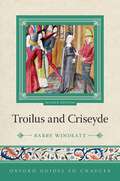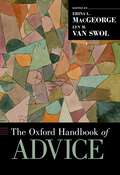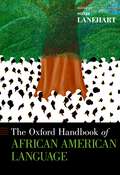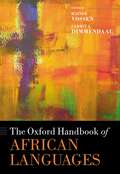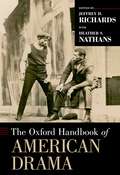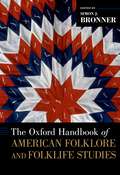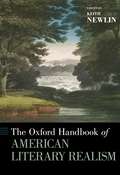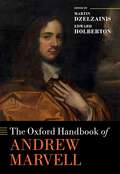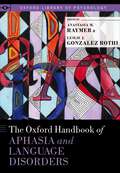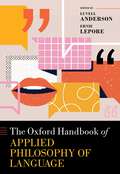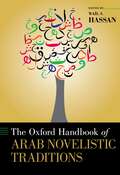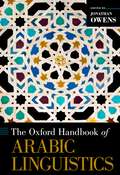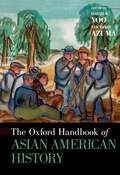- Table View
- List View
Oxford Guides to Chaucer: Troilus and Criseyde (Oxford Guides to Chaucer)
by Prof Barry WindeattThis is a comprehensive critical guide to Chaucer's Troilus and Criseyde. This new edition has been comprehensively revised in light of the latest scholarly and critical research and with a fully updated bibliography. It includes a full account of Chaucer's imaginative deployment of his sources, and an extended survey of this narrative poem's innovative combination of a range of generic identities. The chapters explain how Chaucer builds thematic significance into his poem's symmetrical structure, and the poem's distinctive variety in style and language, as well as a full commentary on the poem's concerns with love in the contexts of time and mutability and human free will. The Guide explores the poem as an extended debate about the nature and value of love, and how love was conceptualized and experienced as a form of service in quest of compassionate reward, a quasi-religious devotion, and a potentially fatal illness always in hope of cure. The subjectivities of the chief protagonists are fully analysed, as is the poem's problematic ending. Alongside discussions of theme and structure, there is also an account of what the extant manuscripts of Troilus and Criseyde may reveal about the poem's early genesis, and a unique survey of responses to Troilus from its own times to the present day. Barry Windeatt's contribution to the series is a comprehensive single-volume guide to Troilus and Criseyde, bringing together a wide range of material and providing a readable commentary on all aspects of the work. Combining the informative substance of a reference book with the coherence of a critical reading, the Guide has taken its place as the standard introduction to Troilus and Criseyde since its first publication in 1992.
The Oxford Handbook of Advice (Oxford Handbooks)
by Erina L. MacGeorge and Lyn M. Van SwolAdvice, defined as a recommendation for action in response to a problem, is a common form of interpersonal support and influence. Indeed, the advice we give and receive from others can be highly consequential, not only affecting us as recipients and advisors, but shaping outcomes for relationships, groups, and organizations. Some of those consequences are positive, as when advice promotes individual problem-solving, or enhances workgroup productivity. Yet advice can also hide ulterior motives, threaten identity, damage relationships, and promote inappropriate action. The Oxford Handbook of Advice provides a broad perspective on how advice succeeds and fails, systematically reviewing and synthesizing theory and research on advice from multiple disciplines, such as communication, psychology, applied linguistics, business, law, and medicine. Several chapters explore advice at different levels of analysis, focusing on advisor and recipient roles, advising interactions and relationships, and advice as a resource and connection in groups and networks. Other chapters address advice in particular types of personal relationships (romantic, family) and professional contexts (workplace, health, education, therapy). Contributing authors also consider cultural differences, advice online, and the ethics of advising. For scholars concerned with supportive communication, interpersonal influence, decision-making, social networks, and related communication processes at work, at home, and in society at large, this Handbook offers historical perspective, contemporary theoretical framing, methodological recommendations, and directions for future research. It also emphasizes practical application, offering clear, concise, and relevant "advice for advising" based on theory and research.
The Oxford Handbook of Advice (Oxford Handbooks)
Advice, defined as a recommendation for action in response to a problem, is a common form of interpersonal support and influence. Indeed, the advice we give and receive from others can be highly consequential, not only affecting us as recipients and advisors, but shaping outcomes for relationships, groups, and organizations. Some of those consequences are positive, as when advice promotes individual problem-solving, or enhances workgroup productivity. Yet advice can also hide ulterior motives, threaten identity, damage relationships, and promote inappropriate action. The Oxford Handbook of Advice provides a broad perspective on how advice succeeds and fails, systematically reviewing and synthesizing theory and research on advice from multiple disciplines, such as communication, psychology, applied linguistics, business, law, and medicine. Several chapters explore advice at different levels of analysis, focusing on advisor and recipient roles, advising interactions and relationships, and advice as a resource and connection in groups and networks. Other chapters address advice in particular types of personal relationships (romantic, family) and professional contexts (workplace, health, education, therapy). Contributing authors also consider cultural differences, advice online, and the ethics of advising. For scholars concerned with supportive communication, interpersonal influence, decision-making, social networks, and related communication processes at work, at home, and in society at large, this Handbook offers historical perspective, contemporary theoretical framing, methodological recommendations, and directions for future research. It also emphasizes practical application, offering clear, concise, and relevant "advice for advising" based on theory and research.
The Oxford Handbook of African American Language (Oxford Handbooks)
by Sonja LanehartThe goal of The Oxford Handbook of African American Language is to provide readers with a wide range of analyses of both traditional and contemporary work on language use in African American communities in a broad collective. The Handbook offers a survey of language and its uses in African American communities from a wide range of contexts organized into seven sections: Origins and Historical Perspectives; Lects and Variation; Structure and Description; Child Language Acquisition and Development; Education; Language in Society; and Language and Identity. It is a handbook of research on African American Language (AAL) and, as such, provides a variety of scholarly perspectives that may not align with each other -- as is indicative of most scholarly research. The chapters in this book "interact" with one another as contributors frequently refer the reader to further elaboration on and references to related issues and connect their own research to related topics in other chapters within their own sections and the handbook more generally to create dialogue about AAL, thus affirming the need for collaborative thinking about the issues in AAL research. Though the Handbook does not and cannot include every area of research, it is meant to provide suggestions for future work on lesser-studied areas (e.g., variation/heterogeneity in regional, social, and ethnic communities) by highlighting a need for collaborative perspectives and innovative thinking while reasserting the need for better research and communication in areas thought to be resolved.
The Oxford Handbook of African American Language (Oxford Handbooks)
by Sonja LanehartThe goal of The Oxford Handbook of African American Language is to provide readers with a wide range of analyses of both traditional and contemporary work on language use in African American communities in a broad collective. The Handbook offers a survey of language and its uses in African American communities from a wide range of contexts organized into seven sections: Origins and Historical Perspectives; Lects and Variation; Structure and Description; Child Language Acquisition and Development; Education; Language in Society; and Language and Identity. It is a handbook of research on African American Language (AAL) and, as such, provides a variety of scholarly perspectives that may not align with each other -- as is indicative of most scholarly research. The chapters in this book "interact" with one another as contributors frequently refer the reader to further elaboration on and references to related issues and connect their own research to related topics in other chapters within their own sections and the handbook more generally to create dialogue about AAL, thus affirming the need for collaborative thinking about the issues in AAL research. Though the Handbook does not and cannot include every area of research, it is meant to provide suggestions for future work on lesser-studied areas (e.g., variation/heterogeneity in regional, social, and ethnic communities) by highlighting a need for collaborative perspectives and innovative thinking while reasserting the need for better research and communication in areas thought to be resolved.
The Oxford Handbook of African Languages (Oxford Handbooks)
by Rainer Vossen Gerrit J. DimmendaalThis book provides a comprehensive overview of current research in African languages, drawing on insights from anthropological linguistics, typology, historical and comparative linguistics, and sociolinguistics. Africa is believed to host at least one third of the world's languages, usually classified into four phyla - Niger-Congo, Afro-Asiatic, Nilo-Saharan, and Khoisan - which are then subdivided into further families and subgroupings. This volume explores all aspects of research in the field, beginning with chapters that cover the major domains of grammar and comparative approaches. Later parts provide overviews of the phyla and subfamilies, alongside grammatical sketches of eighteen representative African languages of diverse genetic affiliation. The volume additionally explores multiple other topics relating to African languages and linguistics, with a particular focus on extralinguistic issues: language, cognition, and culture, including colour terminology and conversation analysis; language and society, including language contact and endangerment; language and history; and language and orature. This wide-ranging handbook will be a valuable reference for scholars and students in all areas of African linguistics and anthropology, and for anyone interested in descriptive, documentary, typological, and comparative linguistics.
The Oxford Handbook of African Languages (Oxford Handbooks)
This book provides a comprehensive overview of current research in African languages, drawing on insights from anthropological linguistics, typology, historical and comparative linguistics, and sociolinguistics. Africa is believed to host at least one third of the world's languages, usually classified into four phyla - Niger-Congo, Afro-Asiatic, Nilo-Saharan, and Khoisan - which are then subdivided into further families and subgroupings. This volume explores all aspects of research in the field, beginning with chapters that cover the major domains of grammar and comparative approaches. Later parts provide overviews of the phyla and subfamilies, alongside grammatical sketches of eighteen representative African languages of diverse genetic affiliation. The volume additionally explores multiple other topics relating to African languages and linguistics, with a particular focus on extralinguistic issues: language, cognition, and culture, including colour terminology and conversation analysis; language and society, including language contact and endangerment; language and history; and language and orature. This wide-ranging handbook will be a valuable reference for scholars and students in all areas of African linguistics and anthropology, and for anyone interested in descriptive, documentary, typological, and comparative linguistics.
The Oxford Handbook of American Drama (Oxford Handbooks)
When one thinks of American Drama, names like Eugene O'Neill, Arthur Miller, and Tennessee Williams readily come to mind. However, as The Oxford Handbook of American Drama shows, the U.S. has a deep and varied tradition that extends back to the years before the Revolutionary War. The essays gathered here trace U.S dramatic history, ranging from plays by Mercy Otis Warren to Tony Kushner. The volume opens with an exploration of the trials and tribulations of strolling players in the colonial era, before shifting to a discussion of the ways plays were deployed for political ends during the Revolution, most notably by the patriot Mercy Otis Warren. The narrative extends to the post-Revolutionary period when plays were used as vehicles to promote republican virtue. Contributors also explore the vibrant drama to emerge during the nineteenth century, when blackface performers and stars such as Edwin Forrest, Charlotte Cushman, and Edwin Booth dominated the stage. The period also witnessed the arrival of the first piece of musical theater, The Black Crook, which is productively situated in a musical tradition that extends to Rodgers and Hammerstein. The Handbook offers a complex treatment of melodrama - the most popular genre of the century. The volume traces the rise of the country's first black acting company in the 1820s, as well as the growing number of ethnic characters presented on the stage. Several of the contributors also highlight the role of women playwrights such as Anna Cora Mowatt in the development of American drama. At the turn of the twentieth century, the Provincetown Players helped to usher in the era of modern drama, which allowed playwrights such as Eugene O'Neill, Susan Glaspell, and Edna St. Vincent Millay to experiment with the form and attempt topics regarded as taboo at the time. As melodrama gave way to realism, exemplified in the work of O'Neill and Rachel Crothers, other dramatic techniques such as naturalism and expressionism were introduced to the stage. Other topics covered in the Handbook include: the political plays of Arthur Miller; the major freedoms brought to the American stage since the 1960s; the new generation of playwrights, such as Tony Kushner and Harvey Fierstein, who created plays dealing explicitly with topics like AIDS and homosexuality; and the rich genealogy of the African American family play in works by Lorraine Hansberry, August Wilson, and Suzan-Lori Parks. The volume concludes with the bold performance art of the Living Theatre and the new multiculturalism that arrived on the contemporary stage, with various ethnic communities --Mexicans, Puerto Ricans, Asians, and Native Americans-becoming the focus of the action. The Oxford Handbook of American Drama presents a comprehensive introduction to the form in all its guises.
The Oxford Handbook of American Folklore and Folklife Studies (Oxford Handbooks)
by Simon J. BronnerThe Oxford Handbook of American Folklore and Folklife Studies surveys the materials, approaches, concepts, and applications of the field to provide a sweeping guide to American folklore and folklife, culture, history, and society. Forty-three comprehensive and diverse chapters delve into significant themes and methods of folklore and folklife study; established expressions and activities; spheres and locations of folkloric action; and shared cultures and common identities. Beyond the longstanding arenas of academic focus developed throughout the 350-year legacy of folklore and folklife study, contributors at the forefront of the field also explore exciting new areas of attention that have emerged in the twenty-first century such as the Internet, bodylore, folklore of organizations and networks, sexual orientation, neurodiverse identities, and disability groups. Encompassing a wide range of cultural traditions in the United States, from bits of slang in private conversations to massive public demonstrations, ancient beliefs to contemporary viral memes, and a simple handshake greeting to group festivals, these chapters consider the meanings in oral, social, and material genres of dance, ritual, drama, play, speech, song, and story while drawing attention to tradition-centered communities such as the Amish and Hasidim, occupational groups and their workaday worlds, and children and other age groups. Weaving together such varied and manifest traditions, this handbook pays significant attention to the cultural diversity and changing national boundaries that have always been distinctive in the American experience, reflecting on the relative youth of the nation; global connections of customs brought by immigrants; mobility of residents and their relation to an indigenous, urbanized, and racialized population; and a varied landscape and settlement pattern. Edited by leading folklore scholar Simon J. Bronner, this handbook celebrates the extraordinary richness of the American social and cultural fabric, offering a valuable resource not only for scholars and students of American studies, but also for the global study of tradition, folk arts, and cultural practice.
The Oxford Handbook of American Folklore and Folklife Studies (Oxford Handbooks)
by Simon J. BronnerThe Oxford Handbook of American Folklore and Folklife Studies surveys the materials, approaches, concepts, and applications of the field to provide a sweeping guide to American folklore and folklife, culture, history, and society. Forty-three comprehensive and diverse chapters delve into significant themes and methods of folklore and folklife study; established expressions and activities; spheres and locations of folkloric action; and shared cultures and common identities. Beyond the longstanding arenas of academic focus developed throughout the 350-year legacy of folklore and folklife study, contributors at the forefront of the field also explore exciting new areas of attention that have emerged in the twenty-first century such as the Internet, bodylore, folklore of organizations and networks, sexual orientation, neurodiverse identities, and disability groups. Encompassing a wide range of cultural traditions in the United States, from bits of slang in private conversations to massive public demonstrations, ancient beliefs to contemporary viral memes, and a simple handshake greeting to group festivals, these chapters consider the meanings in oral, social, and material genres of dance, ritual, drama, play, speech, song, and story while drawing attention to tradition-centered communities such as the Amish and Hasidim, occupational groups and their workaday worlds, and children and other age groups. Weaving together such varied and manifest traditions, this handbook pays significant attention to the cultural diversity and changing national boundaries that have always been distinctive in the American experience, reflecting on the relative youth of the nation; global connections of customs brought by immigrants; mobility of residents and their relation to an indigenous, urbanized, and racialized population; and a varied landscape and settlement pattern. Edited by leading folklore scholar Simon J. Bronner, this handbook celebrates the extraordinary richness of the American social and cultural fabric, offering a valuable resource not only for scholars and students of American studies, but also for the global study of tradition, folk arts, and cultural practice.
The Oxford Handbook of American Literary Naturalism (Oxford Handbooks)
After its heyday in the late nineteenth and early twentieth century, naturalism, a genre that typically depicts human beings as the product of biological and environmental forces over which they have little control, was supplanted by modernism, a genre in which writers experimented with innovations in form and content. In the last decade, the movement is again attracting spirited scholarly debate. The Oxford Handbook of American Literary Naturalism takes stock of the best new research in the field through collecting twenty-eight original essays drawing upon recent scholarship in literary and cultural studies. The contributors offer an authoritative and in-depth reassessment of writers from Stephen Crane, Frank Norris, Theodore Dreiser, and Jack London to Kate Chopin, Edith Wharton, Ernest Hemingway, Richard Wright, John Steinbeck, Joyce Carol Oates, and Cormac McCarthy. One set of essays focus on the genre itself, exploring the historical contexts that gave birth to it, the problem of definition, its interconnections with other genres, the scientific and philosophical ideas that motivate naturalist authors, and the continuing presence of naturalism in twenty-first century fiction. Others examine the tensions within the genre-the role of women and African-American writers, depictions of sexuality, the problem of race, and the critique of commodity culture and class. A final set of essays looks beyond the works to consider the role of the marketplace in the development of naturalism, the popular and critical response to the works, and the influence of naturalism in the other arts.
The Oxford Handbook of American Literary Realism (Oxford Handbooks)
by Keith NewlinThe scholarship devoted to American literary realism has long wrestled with problems of definition: is realism a genre, with a particular form, content, and technique? Is it a style, with a distinctive artistic arrangement of words, characters, and description? Or is it a period, usually placed as occurring after the Civil War and concluding somewhere around the onset of World War I? This volume aims to widen the scope of study beyond mere definition, however, by expanding the boundaries of the subject through essays that reconsider and enlarge upon such questions. The Oxford Handbook of American Literary Realism aims to take stock of the scholarly work in the area and map out paths for future directions of study. The Handbook offers 35 vibrant and original essays of new interpretations of the artistic and political challenges of representing life. It is the first book to treat the subject topically and thematically, in wide scope, with essays that draw upon recent scholarship in literary and cultural studies to offer an authoritative and in-depth reassessment of major and minor figures and the contexts that shaped their work. Contributors here tease out the workings of a particular concept through a variety of authors and their cultural contexts. A set of essays explores realism's genesis and its connection to previous and subsequent movements. Others examine the inclusiveness of representation, the circulation of texts, and the aesthetic representation of science, time, space, and the subjects of medicine, the New Woman, and the middle class. Still others trace the connection to other arts--poetry, drama, illustration, photography, painting, and film--and to pedagogic issues in the teaching of realism. As a whole, this volume forges exciting new paths in the study of realism and writers' unending labor to represent life accurately.
The Oxford Handbook of American Literary Realism (Oxford Handbooks)
The scholarship devoted to American literary realism has long wrestled with problems of definition: is realism a genre, with a particular form, content, and technique? Is it a style, with a distinctive artistic arrangement of words, characters, and description? Or is it a period, usually placed as occurring after the Civil War and concluding somewhere around the onset of World War I? This volume aims to widen the scope of study beyond mere definition, however, by expanding the boundaries of the subject through essays that reconsider and enlarge upon such questions. The Oxford Handbook of American Literary Realism aims to take stock of the scholarly work in the area and map out paths for future directions of study. The Handbook offers 35 vibrant and original essays of new interpretations of the artistic and political challenges of representing life. It is the first book to treat the subject topically and thematically, in wide scope, with essays that draw upon recent scholarship in literary and cultural studies to offer an authoritative and in-depth reassessment of major and minor figures and the contexts that shaped their work. Contributors here tease out the workings of a particular concept through a variety of authors and their cultural contexts. A set of essays explores realism's genesis and its connection to previous and subsequent movements. Others examine the inclusiveness of representation, the circulation of texts, and the aesthetic representation of science, time, space, and the subjects of medicine, the New Woman, and the middle class. Still others trace the connection to other arts--poetry, drama, illustration, photography, painting, and film--and to pedagogic issues in the teaching of realism. As a whole, this volume forges exciting new paths in the study of realism and writers' unending labor to represent life accurately.
The Oxford Handbook of Andrew Marvell (Oxford Handbooks)
by Martin Dzelzainis Edward HolbertonThe Oxford Handbook of Andrew Marvell is the most comprehensive and informative collection of essays ever assembled dealing with the life and writings of the poet and politician Andrew Marvell (1621-78). Like his friend and colleague John Milton, Marvell is now seen as a dominant figure in the literary landscape of the mid-seventeenth century, producing a stunning oeuvre of poetry and prose either side of the Restoration. In the 1640s and 1650s he was the author of hypercanonical lyrics like 'To His Coy Mistress' and 'The Garden' as well as three epoch-defining poems about Oliver Cromwell. After 1660 he virtually invented the verse genre of state satire as well as becoming the most influential prose satirist of the day - in the process forging a long-lived reputation as an incorruptible patriot. Although Marvell himself was an intensely private and self-contained character, whose literary, religious, and political commitments are notoriously difficult to discern, the interdisciplinary contributions by an array of experts in the fields of seventeenth-century literature, history, and politics gathered together in the Handbook constitute a decisive step forward in our understanding of him. They offer a fully-rounded account of his life and writings, individual readings of his key works, considerations of his relations with his major contemporaries, and surveys of his rich and varied afterlives. Informed by the wealth of editorial and biographical work on Marvell that has been produced in the last twenty years, the volume is both a conspectus of the state of the art in Marvell studies and the springboard for future research.
The Oxford Handbook of Andrew Marvell (Oxford Handbooks)
The Oxford Handbook of Andrew Marvell is the most comprehensive and informative collection of essays ever assembled dealing with the life and writings of the poet and politician Andrew Marvell (1621-78). Like his friend and colleague John Milton, Marvell is now seen as a dominant figure in the literary landscape of the mid-seventeenth century, producing a stunning oeuvre of poetry and prose either side of the Restoration. In the 1640s and 1650s he was the author of hypercanonical lyrics like 'To His Coy Mistress' and 'The Garden' as well as three epoch-defining poems about Oliver Cromwell. After 1660 he virtually invented the verse genre of state satire as well as becoming the most influential prose satirist of the day - in the process forging a long-lived reputation as an incorruptible patriot. Although Marvell himself was an intensely private and self-contained character, whose literary, religious, and political commitments are notoriously difficult to discern, the interdisciplinary contributions by an array of experts in the fields of seventeenth-century literature, history, and politics gathered together in the Handbook constitute a decisive step forward in our understanding of him. They offer a fully-rounded account of his life and writings, individual readings of his key works, considerations of his relations with his major contemporaries, and surveys of his rich and varied afterlives. Informed by the wealth of editorial and biographical work on Marvell that has been produced in the last twenty years, the volume is both a conspectus of the state of the art in Marvell studies and the springboard for future research.
The Oxford Handbook of Aphasia and Language Disorders (Oxford Library of Psychology)
by Leslie J. Gonzalez Rothi Anastasia M. RaymerWhat is immediately clear when meeting individuals with acquired brain damage is that the patterns of communication impairments vary in remarkable ways among these individuals. Aphasia and related communication disorders, while devastating life events for individuals who acquire brain damage, provide lessons of considerable interest to many clinicians and researchers trying to understand the brain's neurological and psychological complexity and develop methods to facilitate optimum recovery of lost language and communication functions following brain damage. The Oxford Handbook of Aphasia and Language Disorders weaves theoretical and neurological foundations with rational, motivated clinical approaches to assessment, diagnosis, and intervention for aphasia and related communication disorders. The contributing authors, experienced clinicians and scientists with strong backgrounds in neurological and cognitive neuropsychological theories, bridge theory to clinical practice, reviewing the extant literature in each aphasia syndrome while exploring implications for guiding clinical decision-making. Introductory chapters provide historical perspectives on the aphasia syndromes following left hemisphere brain damage, and review aphasia assessment across the decades. The bulk of the Handbook covers aphasia syndromes, with chapters that describe each aphasia syndrome in detail, including behavioral, neural, and cognitive neuropsychological correlates and methods to assess and treat each syndrome. Additional chapters provide insights into acquired reading and writing disorders and social and prosodic communication disorders that follow damage to the right cerebral hemisphere. The final chapters examine neural perspectives on aphasia recovery and principles of neuroplasticity in aphasia treatment. As such, this book integrates neural, cognitive, and clinical perspectives to provide a broad understanding of the complexity of language and impairments that can arise following acquired brain damage, and will be of interest to scholars and clinicians in the speech-language, neuropsychology, and rehabilitation professions.
The Oxford Handbook of Aphasia and Language Disorders (Oxford Library of Psychology)
What is immediately clear when meeting individuals with acquired brain damage is that the patterns of communication impairments vary in remarkable ways among these individuals. Aphasia and related communication disorders, while devastating life events for individuals who acquire brain damage, provide lessons of considerable interest to many clinicians and researchers trying to understand the brain's neurological and psychological complexity and develop methods to facilitate optimum recovery of lost language and communication functions following brain damage. The Oxford Handbook of Aphasia and Language Disorders weaves theoretical and neurological foundations with rational, motivated clinical approaches to assessment, diagnosis, and intervention for aphasia and related communication disorders. The contributing authors, experienced clinicians and scientists with strong backgrounds in neurological and cognitive neuropsychological theories, bridge theory to clinical practice, reviewing the extant literature in each aphasia syndrome while exploring implications for guiding clinical decision-making. Introductory chapters provide historical perspectives on the aphasia syndromes following left hemisphere brain damage, and review aphasia assessment across the decades. The bulk of the Handbook covers aphasia syndromes, with chapters that describe each aphasia syndrome in detail, including behavioral, neural, and cognitive neuropsychological correlates and methods to assess and treat each syndrome. Additional chapters provide insights into acquired reading and writing disorders and social and prosodic communication disorders that follow damage to the right cerebral hemisphere. The final chapters examine neural perspectives on aphasia recovery and principles of neuroplasticity in aphasia treatment. As such, this book integrates neural, cognitive, and clinical perspectives to provide a broad understanding of the complexity of language and impairments that can arise following acquired brain damage, and will be of interest to scholars and clinicians in the speech-language, neuropsychology, and rehabilitation professions.
The Oxford Handbook of Applied Linguistics (Oxford Handbooks)
by Robert B. KaplanThe Oxford Handbook of Applied Linguistics contains 39 original chapters on a broad range of topics in applied linguistics by a diverse group of contributors. Its goal is to provide a comprehensive survey of the current state of the field, the many connections among its various sub-disciplines, and the likely directions of its future development. The Oxford Handbook of Applied Linguistics addresses a broad audience: applied linguists; educators and other scholars working in language acquisition, language learning, language planning, teaching, and testing; and linguists concerned with applications of their work. Systematically encompassing the major areas of applied linguistics-and drawing from a wide range of disciplines such as education, language policy, bi- and multi-lingualism, literacy, language and gender, neurobiology of language, psycholinguistics and cognition, language and computers, discourse analysis, language and concordances, ecology of language, pragmatics, translation, and many other fields, the editors and contributors to The Oxford Handbook of Applied Linguistics provide a panoramic and comprehensive look at this complex and vigorous field. This second edition includes five new chapters, and the remaining chapters have been thoroughly revised and updated to give a clear picture of the current state of applied linguistics.
The Oxford Handbook of Applied Linguistics (Oxford Handbooks)
by Robert B. KaplanThe Oxford Handbook of Applied Linguistics contains 39 original chapters on a broad range of topics in applied linguistics by a diverse group of contributors. Its goal is to provide a comprehensive survey of the current state of the field, the many connections among its various sub-disciplines, and the likely directions of its future development. The Oxford Handbook of Applied Linguistics addresses a broad audience: applied linguists; educators and other scholars working in language acquisition, language learning, language planning, teaching, and testing; and linguists concerned with applications of their work. Systematically encompassing the major areas of applied linguistics-and drawing from a wide range of disciplines such as education, language policy, bi- and multi-lingualism, literacy, language and gender, neurobiology of language, psycholinguistics and cognition, language and computers, discourse analysis, language and concordances, ecology of language, pragmatics, translation, and many other fields, the editors and contributors to The Oxford Handbook of Applied Linguistics provide a panoramic and comprehensive look at this complex and vigorous field. This second edition includes five new chapters, and the remaining chapters have been thoroughly revised and updated to give a clear picture of the current state of applied linguistics.
The Oxford Handbook of Applied Philosophy of Language (Oxford Handbooks)
by Luvell Anderson and Ernie LeporeThis Handbook represents a collective exploration of the emerging field of applied philosophy of language. The volume covers a broad range of areas where philosophy engages with linguistic aspects of our social world, including such hot topics as dehumanizing speech, dogwhistles, taboo language, pornography, appropriation, implicit bias, speech acts, and the ethics of communication. An international line-up of contributors adopt a variety of approaches and methods in their investigation of these linguistic phenomena, drawing on linguistics and the human and social sciences as well as on different philosophical subdisciplines. The aim is to map out fruitful areas of research and to stimulate discussion with thought-provoking essays by leading and emerging philosophers.
The Oxford Handbook of Applied Philosophy of Language (Oxford Handbooks)
This Handbook represents a collective exploration of the emerging field of applied philosophy of language. The volume covers a broad range of areas where philosophy engages with linguistic aspects of our social world, including such hot topics as dehumanizing speech, dogwhistles, taboo language, pornography, appropriation, implicit bias, speech acts, and the ethics of communication. An international line-up of contributors adopt a variety of approaches and methods in their investigation of these linguistic phenomena, drawing on linguistics and the human and social sciences as well as on different philosophical subdisciplines. The aim is to map out fruitful areas of research and to stimulate discussion with thought-provoking essays by leading and emerging philosophers.
The Oxford Handbook of Arab Novelistic Traditions
The Oxford Handbook of Arab Novelistic Traditions is the most comprehensive treatment of the subject to date. In scope, the book encompasses the genesis of the Arabic novel in the second half of the nineteenth century and its development to the present in every Arabic-speaking country and in Arab immigrant destinations on six continents. Editor Waïl S. Hassan and his contributors describe a novelistic phenomenon which has pre-modern roots, stretching centuries back within the Arabic cultural tradition, and branching outward geographically and linguistically to every Arab country and to Arab writing in many languages around the world. The first of three innovative dimensions of this Handbook consists of examining the ways in which the Arabic novel emerged out of a syncretic merger between Arabic and European forms and techniques, rather than being a simple importation of the latter and rejection of the former, as early critics of the Arabic novel claimed. The second involves mapping the novel geographically as it took root in every Arab country, developing into often distinct though overlapping and interconnected local traditions. Finally, the Handbook concerns the multilingual character of the novel in the Arab world and by Arab immigrants and their descendants around the world, both in Arabic and in at least a dozen other languages. The Oxford Handbook of Arab Novelistic Traditions reflects the current status of research in the broad field of Arab novelistic traditions and signals toward new directions of inquiry.
The Oxford Handbook of Arabic Linguistics (Oxford Handbooks)
by Jonathan OwensArabic is one of the world's largest languages, spoken natively by nearly 300 million people. By strength of numbers alone Arabic is one of our most important languages, studied by scholars across many different academic fields and cultural settings. It is, however, a complex language rooted in its own tradition of scholarship, constituted of varieties each imbued with unique cultural values and characteristic linguistic properties. Understanding its linguistics holistically is therefore a challenge. The Oxford Handbook of Arabic Linguistics is a comprehensive, one-volume guide that deals with all major research domains which have been developed within Arabic linguistics. Chapters are written by leading experts in the field, who both present state-of-the-art overviews and develop their own critical perspectives. The Handbook begins with Arabic in its Semitic setting and ends with the modern dialects; it ranges across the traditional--the classical Arabic grammatical and lexicographical traditions--to the contemporary--Arabic sociolinguistics, Creole varieties and codeswitching, psycholinguistics, and Arabic as a second language - while situating Arabic within current phonetic, phonological, morphological, syntactic and lexicological theory. An essential reference work for anyone working within Arabic linguistics, the book brings together different approaches and scholarly traditions, and provides analysis of current trends and directions for future research.
The Oxford Handbook of Asian American History (Oxford Handbooks)
by David K. Yoo and Eiichiro AzumaAfter emerging from the tumult of social movements of the 1960s and 1970s, the field of Asian American studies has enjoyed rapid and extraordinary growth. Nonetheless, many aspects of Asian American history still remain open to debate. The Oxford Handbook of Asian American History offers the first comprehensive commentary on the state of the field, simultaneously assessing where Asian American studies came from and what the future holds. In this volume, thirty leading scholars offer original essays on a wide range of topics. The chapters trace Asian American history from the beginning of the migration flows toward the Pacific Islands and the American continent to Japanese American incarceration and Asian American participation in World War II, from the experience of exclusion, violence, and racism to the social and political activism of the late twentieth century. The authors explore many of the key aspects of the Asian American experience, including politics, economy, intellectual life, the arts, education, religion, labor, gender, family, urban development, and legal history. The Oxford Handbook of Asian American History demonstrates how the roots of Asian American history are linked to visions of a nation marked by justice and equity and to a deep effort to participate in a global project aimed at liberation. The contributors to this volume attest to the ongoing importance of these ideals, showing how the mass politics, creative expressions, and the imagination that emerged during the 1960s are still relevant today. It is an unprecedentedly detailed portrait of Asian Americans and how they have helped change the face of the United States.
The Oxford Handbook of Asian American History (Oxford Handbooks)
After emerging from the tumult of social movements of the 1960s and 1970s, the field of Asian American studies has enjoyed rapid and extraordinary growth. Nonetheless, many aspects of Asian American history still remain open to debate. The Oxford Handbook of Asian American History offers the first comprehensive commentary on the state of the field, simultaneously assessing where Asian American studies came from and what the future holds. In this volume, thirty leading scholars offer original essays on a wide range of topics. The chapters trace Asian American history from the beginning of the migration flows toward the Pacific Islands and the American continent to Japanese American incarceration and Asian American participation in World War II, from the experience of exclusion, violence, and racism to the social and political activism of the late twentieth century. The authors explore many of the key aspects of the Asian American experience, including politics, economy, intellectual life, the arts, education, religion, labor, gender, family, urban development, and legal history. The Oxford Handbook of Asian American History demonstrates how the roots of Asian American history are linked to visions of a nation marked by justice and equity and to a deep effort to participate in a global project aimed at liberation. The contributors to this volume attest to the ongoing importance of these ideals, showing how the mass politics, creative expressions, and the imagination that emerged during the 1960s are still relevant today. It is an unprecedentedly detailed portrait of Asian Americans and how they have helped change the face of the United States.
